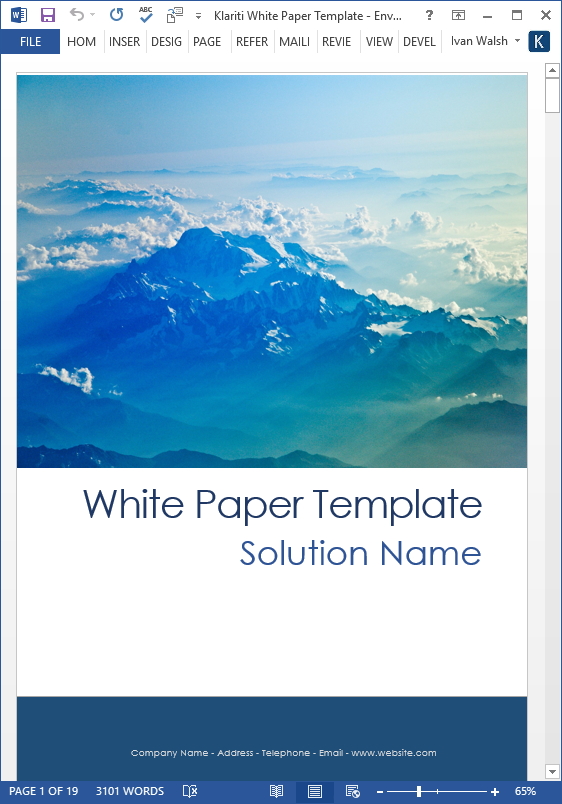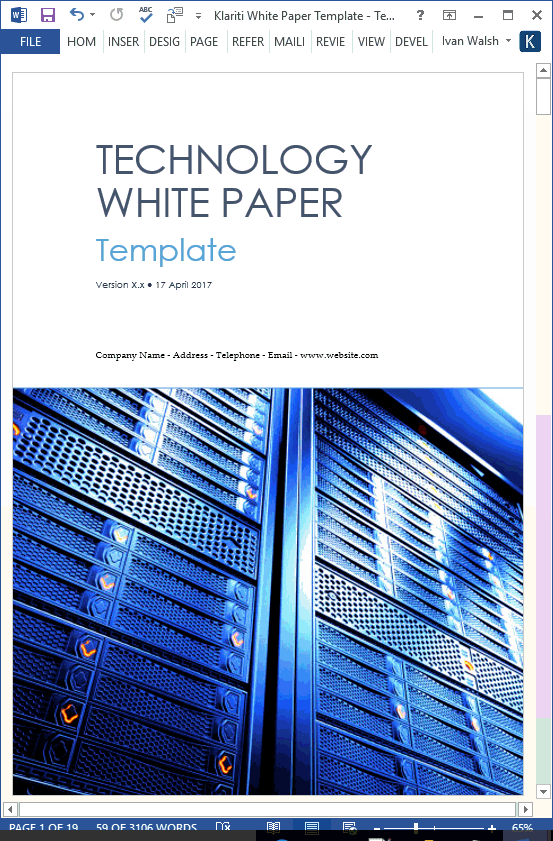White Paper Templates
10 Tactics For Writing B2B White Papers
If I could show you a way to generate leads – with very little cost and not that much effort – would you be interested? Who wouldn’t, right?
As a lead generation tool, I came across white papers by accident. One of my colleagues had left technical writing and moved into a new field. We’d lost touch as often happens. But when I caught up with him about three years later in Hammersmith, he was writing white papers, mostly for the financial services industry.
15 royalty-free MS Word White Paper templates.
White Paper templates – MS Word and Excel
Learn More about these white paper templates
Contently suggest that, “White papers are great tools for generating credibility. Customers respond better to informative write-ups than they do to blatant ads. The trick is to make sure your white paper is organized and well thought out so that you will create a natural and genuine interest in your services.”
It turns out that writing white papers – which he preferred to call Special Reports on Industry Reports – paid very well and didn’t require all the much re-skilling. Since then I’ve focussed in this area and written for international banks and NASDAQ-listed software companies.
Can small businesses, especially B2B, use white papers to generate leads?
Absolutely.
The thing is… white papers can work just as well for small businesses as multi-nationals. I’ve been writing B2B marketing documents for over seventeen years and – without exception – white papers outperform all other types of sales documents when it comes to generating leads.
Why are technology white papers so popular?
It’s mostly to do with… perception.
Most of us throw away direct mail and and email pitches. They’re usually of little value and, at least for email, get caught by spam filters anyway.
So, the perception is that they’re of little value.
But white papers are perceived as a higher value document which may explain why we’re often reluctant to delete that special report or marketing blueprint.
It feels more important – it’s a white paper. It has a certain type of gravity.
Jim Lodico at JAL Communications recommends that, “One of the most important yet most overlooked steps in creating a white paper is to clearly define the goals and objectives of the project. Many potentially great white papers fail because the outcome of the campaign was never clearly established.”
How to Write B2B White Papers That Generate Leads
Let’s take a look: which type of marketing document do you think generates the most leads?
- Case studies
- White papers
- Special reports
- Data sheets
If you have a limited marketing budget, consider writing a series of white papers to generate leads for your products or services. It’s not hard to do but there are a few pitfalls to avoid.
Richard Hollins make the point that you also need to figure out the problem’s emotional impact. “If the problem you’ve identified is genuinely significant to your prospects, they’ll be feeling powerful emotions about it. These will probably be variations of fear or greed.”
Here are ten ways to write white papers for the B2B community:
- Educate Prospects – Why are white papers more successful than other types of sales documents? Because they focus on educating the prospect. Or at least the good ones do. Any document that helps you understand your problem a little better is of value. And white papers should focus on educating their potential clients. This shift from ‘selling’ to ‘helping’ is what disarms prospects. They don’t see the pitch as it’s wrapped up in a different package.
- Provide Solutions – The other side of the pitch is that you provide a real solution. Again, self-promotion copy doesn’t work here as we’re all trained to filter out hard sell direct pitches. Instead demonstrate, possibly with case studies, how your solution solved a real world issue. Endorsements from satisfied clients further cement your reputation.
- Natural Language – Write in the same language as your prospects. Actually, stop calling them prospects. When you’re writing the white paper, imagine they’re sitting across the table from you – write for that person.
- Create buzzwords – Shakespeare created over 3,000 new words. Dave Allen made GTD his own. Seth Godin has purple cows. Chris Brogan. Trust Agent. You can position yourself as an authority or visionary by inventing new buzzwords and then urging others to use these in their blog posts and articles. Once people connect you with that word, you’re perceived as owning it. You’re seen as the expert.
- Understand Prospect Immediate Needs – One mistake to avoid is to assume that all potential clients are at same place in the decision making process. Some are starting out. Others have completed their research and are ready to buy. Craft your message so that it aligns with their current needs.
- Partner with Bigger Partners – You’ll get more publicity if you work with a bigger partner as they can promote your white paper to a wider audience. While you may have to do the writing, editing and publishing, your parter’s reach will make the effort worthwhile. This is critical is you want to get the message into verticals and channels where you have little influence.
- Demonstrate the ROI – Show me the money as the man said. You immediately change the tone of an abstract white paper into something more tangible by introducing financials. Of all the tactics for getting your reader’s attention, discussing how you made (or saved) money is probably the most effective. Again – show me the money!
- Emotional Triggers – One advertising theory is that we choose with our heart but justify the decision with our head. If this is true, look at emotion triggers, such as vanity, fear, and doubt, to encourage your readers to take action. Want an example? If you write a white paper – 7 ways to reduce content management costs – people in the content management world will feel compelled to read it. Why? Because they’re curious and want to check that they know all seven. No one wants to get left behind, right?
- Call to Actions – The reason most white papers fail is because they don’t ask the reader to do something. So, what do the readers do? That’s right, nothing. If you want readers to take action, for instance, phone you, sign up for your newsletter or download a trial subscription, then remind them to do so. In several places. With different colored fonts.
- Create Urgency – Ever seen those ads on TV that say, ‘only two days left’? Even though you don’t want to, you find yourself thinking, ‘Well, maybe I’ll go over there, just in case…’ That’s how urgency works. Look for ways to inject urgency into your white papers. For example, make the white paper free… for the first 100 downloads. After that, it’s $97 USD. No one wants to pay that, so they’ll sign up. Don’t believe me? Send out a tweet at 11am on a Thursday and see what happens. They’ll sign up 🙂
Conclusion
Most white papers fail to generate leads as the focus is on selling instead of establishing authority.
Instead, write your white paper so that it teaches the reader how to solve a problem, feel better informed, or confident enough to share it with their colleagues. Not only will this work for lead generation but will develop your reputation as a provider of quality materials. The type everyone looks to when they have a query.
Do they need to change the language, the tone, length or something else?
15 x White Paper Templates for only $19.99
Learn More about these White Paper Templates



